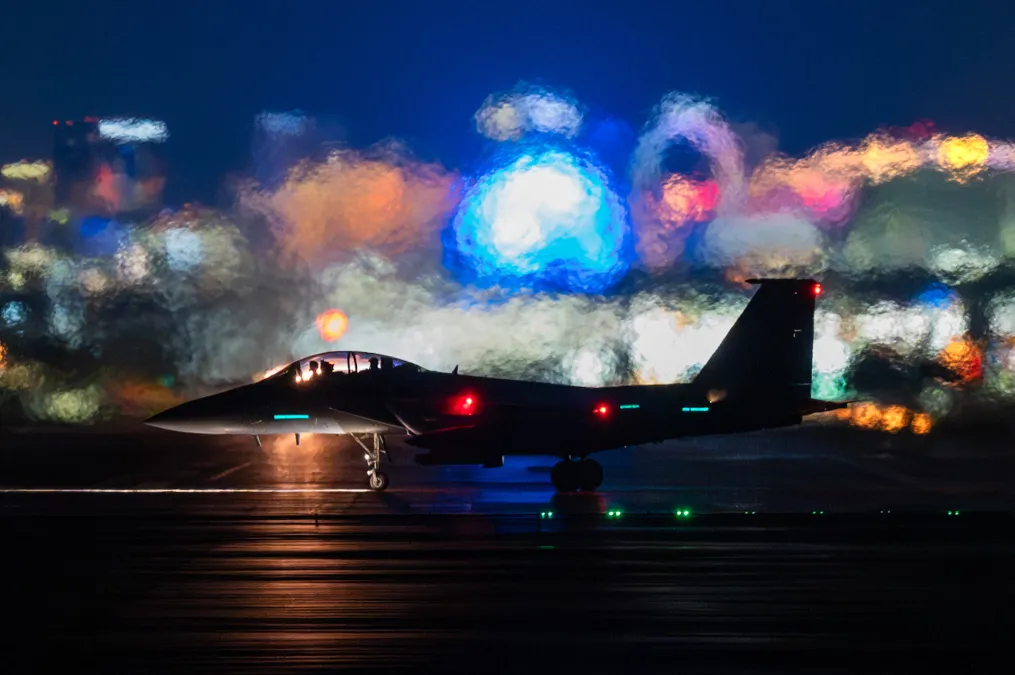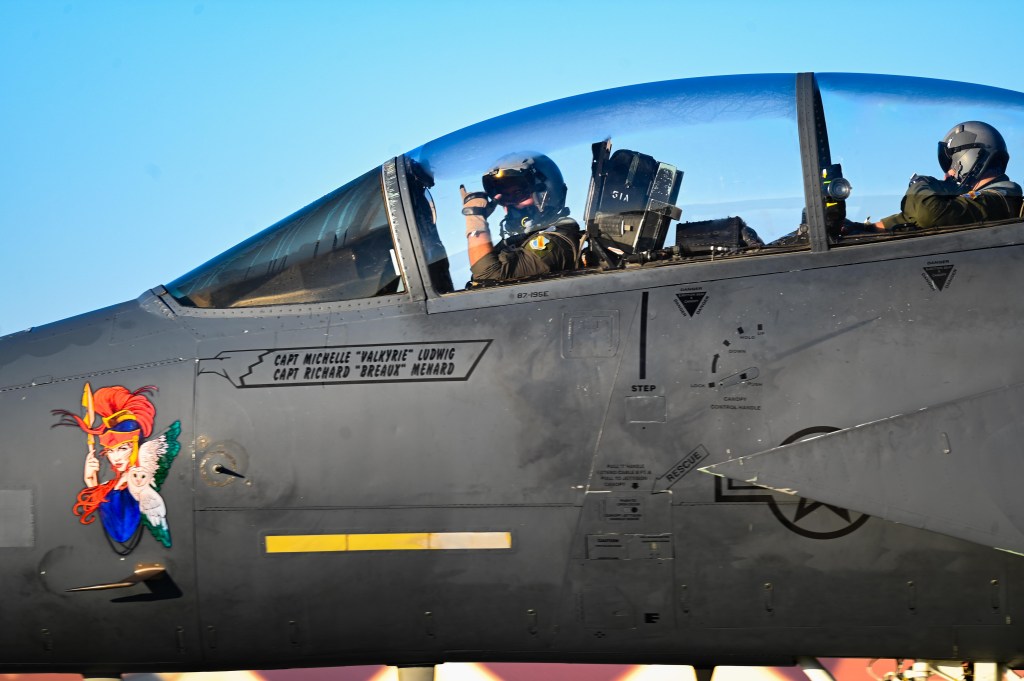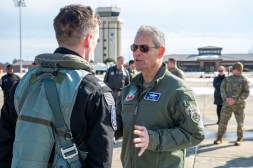Air Force looking to disaggregate electronic warfare capabilities from platforms

This is part one of a two-part series exploring how the Air Force is aiming to modernize and reinvigorate electronic warfare within its capability portfolio. Part two can be found here.
NATIONAL HARBOR, Md. — The Air Force is moving away from a platform-centric view of electronic warfare to more of a system-of-systems approach as it revamps its EW arsenal.
The service has been a platform-centric organization historically — meaning it has relied on systems such as aircraft to perform both its mission and contribution to the joint force — but the modern electromagnetic spectrum environment and threat landscape are demanding a new paradigm.
“Most of our electronic warfare programs are platform centric, so there wasn’t a unifying focus on this area as a whole. My own experience suggested that this is a historically neglected area that can have oversized impact, but doesn’t compete well in our internal budget battles relative to other priorities,” Air Force Secretary Frank Kendall said last week at AFA’s Air, Space and Cyber conference.
The Air Force — much like the rest of the U.S. military — has been on a multi-year journey to modernize its outlook on electronic warfare, with officials acknowledging the airborne electronic attack mission for years was driven primarily by the Navy. Similar to other services, at the end of the Cold War it divested in many of its advanced capabilities, such as the venerable EF-111A Raven. Now, the Air Force has set off on a journey to reinvigorate its EW approach and capabilities.
Those at the AFA conference were encouraged by the attention electronic warfare is now getting at top levels of the service after years of neglect.
“I am excited with the direction the Air Force is going,” David Gaedecke, senior executive advisor at Booz Allen Hamilton, said in an interview.
Gaedecke, a retired two-star general who prior to retiring most recently served as vice commander of 16th Air Force, led the service’s major study over six years ago, known as the Enterprise Capability Collaboration Team, that sought to dive deeper into electromagnetic spectrum issues and develop reforms. That study led to clear changes that the Air Force has implemented, such as new organizations and commands.
“We went from an ECCT at the direction of chief of staff of the Air Force … to yesterday, where I’m sitting in a suit in a room and I’m listening to the secretary of the Air Force and I knew how important the [operational imperatives] were and then for him to say, ‘Hey, there’s four other things that I need to focus on, and the two I’m going to mention today are mobility and EW,’” Gaedecke said. “I was like, that alone is progress. I mean, that’s significant progress that the secretary of the Air Force is on the stage acknowledging that, because we all know that. Everybody heard him say it. That matters.”
Kendall and other officials described how the service has added electronic warfare as a cross-cutting enabler for its seven operational imperatives, undergoing a study associated with that effort. As a result, the Air Force is trying to utilize a more holistic approach to EW that takes into account other tools and capabilities beyond just the aircraft it flies.
Officials said the new Integrated Capabilities Command — which will work on operational concepts, new requirements and modernization plans so commands can focus on warfighting – and Integrated Capabilities Office — which is focused on improving acquisition — will play a huge role in the future when it comes to disaggregating electronic warfare from platforms and getting to a place where the right capabilities are used for the right missions.
“Having that type of functionality and those people taking a look to how we counter any type of adversary data links, communication … part of the data links, obviously, cyber systems, intel, surveillance — all of those type of things to counter that effectively with offensive EA has to be a collaborative effort,” Brig. Gen. Leslie Hauck, director of the electromagnetic spectrum superiority directorate within the A2/6L, said in an interview at the AFA conference.
There are space and cyber capabilities that can be utilized to defeat what officials call “kill webs” from the adversary, enabling tools that involve communications systems and networks that contribute to finding a target, tasking a weapon and engaging that target kinetically or non-kinetically.
“The rule and prominence of electronic warfare in the war in Ukraine provided additional incentives. What the team discovered was incredibly important. We believe we can counter advanced adversary kill webs by integrating a combination of electronic warfare tools, operationalized cyber capability and other elements. I’m excited to see us making fast progress on this mission area for the Department of the Air Force,” Kendall said.
He later told reporters at the conference that electronic warfare also extends to space and vice versa, noting that officials identified “very promising” technologies through the cross-cutting operational enabler study over the last year. Although Kendall said he couldn’t provide much detail given the classified nature of the effort, he suggested the department is looking at integrating cyber and electronic warfare together for greater effect.

Some sources indicated the Air Force’s emerging cyber-enabled air superiority concept — the service’s attempt to build its own tactical cyber capabilities separate from U.S. Cyber Command and focused solely on Air Force missions — will play a role here.
“There are a number of things that I think offer a lot of potential for us that we’re trying to explore. I think writ large, you can expect more emphasis on electronic warfare going forward,” Kendall told reporters.
Others noted that in order to affect adversary kill webs, the Air Force must shift to a system-of-systems approach vice a platform approach.
“When we look at collectively, the pacing threat China, it’s all about kill chains. It’s about enabling the blue kill chain, it’s about disrupting the red kill chain. And [in] the future fight you can’t just do that with a platform-centric view,” Joshua Niedzwiecki, vice president and general manager of electronic combat solutions at BAE Systems, said at the conference. “We’re excited that with the ICC and things like the Integrated Capability Office, there now becomes a mechanism for us to look at the problem differently and integrate capability across multiple platforms and multiple systems … Today everything is spec’d and designed in a platform-centric way, and so the requirements are defined for each platform. What that creates as a bit of a gap is the ability to leverage capability and to drive costs down across platforms.”
He noted his hope for the ICC is there’s a mechanism to push alignment across various platforms and capabilities.
It all comes down to reducing costs and getting the biggest return on investment for the Air Force.
“EW traditionally has been an area that has had a little bit of trouble competing with platforms and weapons and other things, but it’s incredibly important on the battlefield. As the war in Ukraine is showing, that’s becoming even more so,” Kendall told reporters.
Hauck explained that when the service engages with industry, requests are based on which part of the kill chain is most beneficial that will allow the military to win and to dominate across kinetic and non-kinetic warfighting realms, emphasizing it is a cross-cutting, collective effort.
“Back to the return on investment, so that then we can go to the Office of [the] Secretary of Defense and DOD writ large and show that we’ve got a good plan collectively to spend money in the right places, that’s really what it allows us to do,” he said of these new organizations the Air Force is creating that will seek to bring a more collaborative approach between industry, acquisition officials and operators.
Doing more with less
Currently, the Air Force has a limited number of dedicated electronic attack aircraft. The revamped Compass Call — now designated the EA-37B, outfitted to a Gulfstream G550 business jet as opposed to the EC-130H — was only just delivered to Davis Monthan Air Force Base, Arizona, in August to begin pilot training. While extremely capable, this platform will become a high-demand, low-density asset given the limited number of aircraft and budget constraints.
Earlier this year, the previous commander of U.S. Indo-Pacific Command, Adm. John Aquilino, told Congress the new Compass Call provides great capability and he needed more for that region than what the Air Force was funded for. He noted the only caveat to that would be if there was another mechanism to deliver the capability Compass Call provides, in which case Indo-Pacom could do with less EA-37Bs. But “we do need the capabilities that currently reside in that aircraft,” he said.
“The EA-37B represents one of the major Air Force EMSO modernization efforts, and it’s a great move, along with electronic warfare capabilities integrated with our 5th-gen-and-beyond aircraft systems. The real issue is that we need more EA-37Bs than the current budget allows,” retired Lt. Gen. David Deptula, dean of the Mitchell Institute for Aerospace Studies, said in a September podcast. “If the nation is really serious about being able to execute the current national defense strategy, we’re going to need more.”

In that limited budget environment, the Air Force will have to figure out how to make other platforms capable in the spectrum, either with their internal self-protection capabilities that have electronic attack — albeit less powerful than dedicated jamming platforms — or possibly unmanned systems such as collaborative combat aircraft.
“The Air Force is still buying Compass Calls trying to figure out what that number is. Then what do you do otherwise? What do you do about putting that capability on something else that will reach out, reduce the threat range of an adversary, so that you can drive in closer to drop your ordnance, so you can support your weapons all the way to the target?” Chuck Angus, director of business development in naval power at Raytheon, said in an interview at the AFA conference.
He noted that if the Air Force has platforms with a lot of persistence such as a drone or even a bomber, they can be useful for enabling kinetic operations.
“If you had a platform that had a lot of persistence — think about a UAS, think about a bomber that can fly for hours and hours and hours — then you probably have a platform that is very useful in this space … You can not only fly it in the area, but when they drop their weapons, you support those weapons all the way to target,” Angus said. “Magazine depth is really important. This non-kinetic electronic attack will increase that magazine depth because you have to shoot less. Those weapons will get to the target better, be more successful and then you can move to another target.”
The Air Force is looking at how to marry these capabilities with overall cost in mind, in a constrained fiscal environment.
“We’re trying to collectively look at the system with the force design that the A5/7 team has been working on to figure out how we do this the most affordable, but then also achieving the objectives that we need, but not buying the exquisite platform necessarily that’s going to — as we’ve heard the secretary and others say and the chief — that’s going to last forever,” Hauck said.
Dedicated electronic attack platforms such as the Compass Call are very good at what they do, he added, but the Air Force has to have the collective enterprise doing electronic warfare and some level of electronic attack. They must understand what the right number of platforms to purchase are and where to invest for the best bang for the buck.
“If you’re talking about a platform that’s putting a pod on, it could be important, depending on what that platform does and depending on the cost,” Hauck said. “We couldn’t just isolate ourselves and figure out a single electronic warfare solution that connected against one part of the adversary’s kill web. It has to be something that knows what the B-21 might be able to bring, that knows whatever other platform, [Next-Generation Air Dominance], CCA, you name it, might be able to bring to the fight and where they’re going to be in the flight.”
Similarly, Gaedecke explained that reading the tea leaves from what senior leaders have said, the approach is integrating different capabilities across the breadth of platforms and systems.
“How do you take these existing capabilities and integrate them across portfolio? How do you have the requirements that are integrated to solve multiple problems, versus one-off solutions for all of these different things?” he said. “When I was in uniform and I did the ECCT, I think a lot of people thought that I was going to help them solve the EF-111 replacement … [but] that’s tougher in the budget environment for the department to be able to do that. If you can’t do that with a solution, how do you do it? Even when you listen to the secretary talk about NGAD and the family of systems, again, I think through the family of systems and the capabilities you integrate versus the dedicated platform.”
All that tied to a robust battle management of the electromagnetic spectrum will be paramount to ensure forces aren’t jamming themselves, and the right platforms in the right areas are being utilized.
“You need electromagnetic battle management capability to orchestrate which platforms are going to provide which electronic fires, similar to an air battle manager,” Niedzwiecki said. “Every platform fights the threat environment as a one-versus-many fight. Every platform has to be able to close the kill chain itself and it has to be able to address all possible threats that it will face to deny red [forces]. As we look forward with things like counter-C5ISRT, it really drives the need to build collaborative, coordinated effects across the battle space.”
DefenseScoop reporter Mikayla Easley contributed to this story.
Part two of this series will focus on how the Air Force is maturing and exercising its reprogramming enterprise.






